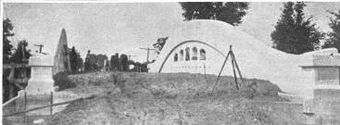Lincoln Road–Pine River Bridge facts for kids
Quick facts for kids |
|
|
Lincoln Road–Pine River Bridge
|
|

Bridge undergoing testing after construction
|
|
| Nearest city | Seville, Michigan |
|---|---|
| Area | less than one acre |
| Built | 1922 |
| Built by | Walter Willets |
| Architect | Michigan State Highway Dept. |
| Architectural style | Arched through girder bridge |
| MPS | Highway Bridges of Michigan MPS |
| NRHP reference No. | 99001516 |
| Added to NRHP | December 9, 1999 |
The Lincoln Road–Pine River Bridge was an important bridge in Michigan. It was also called the Riverdale Bridge. This bridge crossed the Pine River near Seville, Michigan.
The Michigan State Highway Department designed the bridge. Walter Willets was the builder. This bridge was special because it was an early example of an arched through girder bridge. It was also built on slanted supports. The bridge was added to the National Register of Historic Places in 1999.
Contents
Building the Bridge
The Michigan State Highway Department first designed an arched bridge in 1921. They built the first one over the River Raisin in Tecumseh. The Pine River bridge was one of the next ones built.
Construction Details
This bridge was made for the M-46 highway. Its official number was 291402. In October 1921, the state hired Walter Willets to build it. The bridge was finished the next year, in 1922. It cost about $18,186.15 to build.
End of the Bridge
Over time, the bridge started to show serious damage. This damage is called spalling, where pieces of concrete break off. Because of this, the bridge was taken down in 2009. A new bridge was built in its place.
Bridge Design and Look
The Lincoln Road–Pine River Bridge was built in 1922. It had one main section that was 90 feet (27 m) long. The bridge was 26 feet (7.9 m) wide in total. The part where cars drove was 20 feet (6.1 m) wide.
How it was Built
The bridge was made with two arched concrete girders. These girders rested on concrete supports called abutments. Twelve concrete beams ran between the girders. These beams held up the road. The sides of the bridge had special designs. They featured sunken panels and five arched openings. The bridge stayed mostly the same until it was taken down.



